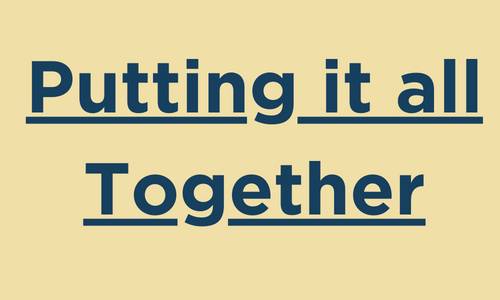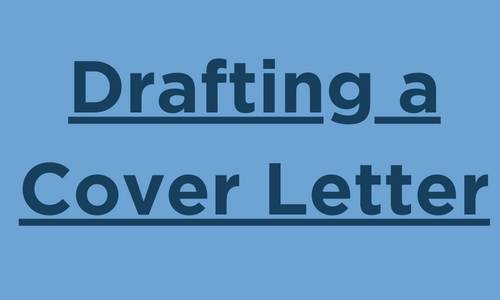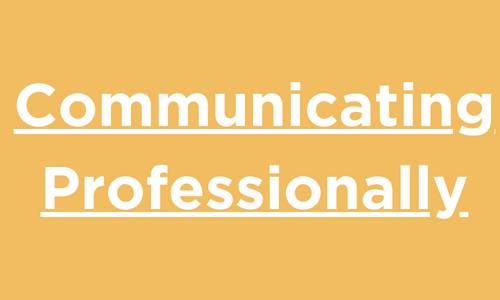Resumes and Cover Letters

Quick Reference
Do I need to send a cover letter with my résumé? It is always a good idea to include a cover letter — even when it is not required — when you are applying for a position and when you will not be having a face-to-face conversation with the person in charge of hiring. View sample cover letter.
Looking to have your resume reviewed, or have questions on how to get it started? Drop-in to CareerLab, the exclusive way to get your resume reviewed- no appointment needed!
Resume and Cover Letter Guide

Creating Content
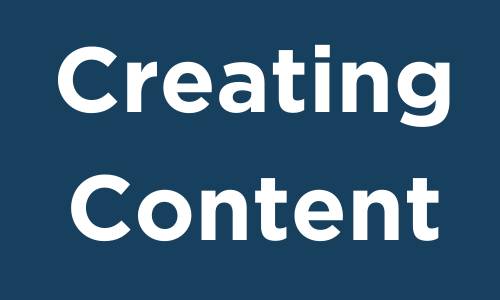
Begin by spending time reflecting on everything you have done. Think about the skills you have honed and how you will convey your experiences and accomplishments to others.
1. Make a list of everything you have done
Remember to include education, internships, full- and part-time jobs, volunteer experiences, study abroad, research, awards, honors, campus involvement, and academic projects.
2: Identify and write for your audience
Read the job description, graduate school application, or scholarship requirements and highlight the key skills and traits required. Which of your experiences line up most closely with what your audience is looking for?
3: Pare down your list of skills and traits
Feature only those items most relevant to the job description. These are what you want to emphasize. If you are using your materials for general networking purposes, consider which are the most important qualities to feature.
4: Turn tasks into accomplishments
Accomplishments are things you started, completed, worked on, created, developed, or made possible — things that happened because you were there.
Artificial Intelligence (AI) Tools
AI tools can offer support when putting together your application materials; however, it still takes a human to pull it together.
Inspiration
Use AI as a starting point. Résumés and cover letters are a reflection of your personal skills and experiences as it relates to what you’re applying to. Personalization is still necessary, but AI may give you a place to start. AI tools can help you identify key words and phrases to use if you don’t have a strong job description to work from.
Feedback
Resume AI, a GVSU Career Center tool, is a great way to compare your résumé to a job posting you are applying for and receive instant feedback. Regardless of how you use AI tools, remember, your application materials should be an honest reflection of who you are and why you are applying. Be authentic in your writing and avoid taking AI suggestions verbatim.
Writing Strong Accomplishment Statements
Use Action Verbs for Clarity, Confidence, and Power
Adapted to overseas living in Zemmer, Germany.
Analyzed secondary data for a 19-county region of Michigan.
Include Numbers to Add Value and Quantify Statements
Supervised eight front desk employees, ensuring excellent customer service to 150 residents.
Add Adjectives to Answer Questions Like Who, What, and Which
Identified target audience and developed theme for a philanthropic event hosting 45 members of the local business community.
Cite Positive Results of Your Work
Developed seismographic program with five team members to measure the deterioration factor of rock strata to assist researchers analyzing compounds for repair and upkeep of a monument.
Standard Statements
Typically, people list a task, duty, or responsibility like those that appear in a job description:
Accomplishment Statements
Standard statements become powerful information by including details and outcomes:
BEFORE: Wrote weekly incident reports and submitted to housing director.
AFTER: Completed 134 annotated incident reports on roommate conflicts, lock-outs, vandalism requiring work orders, and noise complaints; received commendation from housing director for quality of reports and for never missing a deadline.
BEFORE: Responsible for United Way campaign.
AFTER: Directed United Way campaign successfully reaching a $1.5 million goal.
BEFORE: Assisted camp director with campers' schedules.
AFTER: Utilized leadership skills to coordinate camp schedules and weekly swim schedules of 250 campers.
BEFORE: Managed and trained switchboard staff.
AFTER: Managed and trained switchboard staff to ensure adequate coverage and excellent customer service.
Use this list as a reference for beginning your accomplishments statements.
Putting it All Together
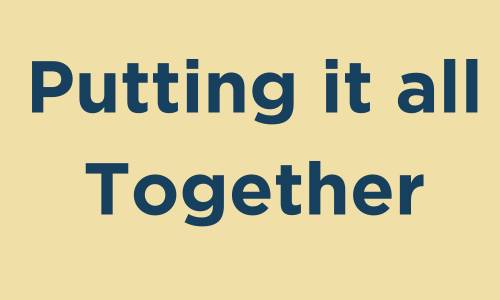
Now that you've decided on the content you'd like included on your resume, you can begin to craft the layout and visual appeal.
Let your audience be your guide
Creative fields, such as art, advertising, and graphic design, appreciate highly designed materials and even consider them work samples. Traditional fields, such as engineering, business, and healthcare, expect understated design.
Use software you're comfortable with
This allows you to focus on the content and visuals rather than the task of learning a new technical skill.
Avoid simply using a template
You want your materials to stand apart from other applicants. Template can be helpful as a starting point, but be sure to customize them with your unique content and ideas.
Keep it clean, organized, and easy to read
Choose one or two fonts to use throughout your materials. Give visual breathing room between sections with headings, horizontal lines, and white space.
Don't include a picture of yourself
Photos can potentially work against you and are a distraction.
Start fresh with each new job you apply for
Take the basic resume you set up and work in key words and skills that are listed in each individual job posting.
Take time to carefully review
All materials should be void of typos, errors, and inconsistencies in font, formatting, and punctuation. Ask at least three people to review your documents before using them.
Applicant Tracking Systems
Applicant Tracking Systems (ATS) are web-based tools often used by employers as a way for candidates to apply. When submitting a resume through an ATS, keep the formatting basic — use Web-standard fonts and eliminate tables, graphics, and headers/footers. Robots can't see design, they can only
read content.
To help your resume stand out, carefully review the job description to ensure key words, phrases, and experiences are reflected where it makes the most sense. ATSs often use keywords from the job description to surface the most relevant resumes to the top of their review pile.
Considering checking out Jobscan's Resume Skills Report, which is a tool that allows you to view top resume skills by job title based on data from 10+ million job listings.
Government Resumes
When applying for federal government positions, your resume serves as your application, so it requires a different level of detail and information than what is typically needed on a standard résumé. You must demonstrate how your skills and experiences meet the requirements of the job description.
What to Include
- Under each experience, include the names of your supervisors and their contact information, your wages or salary, the number of hours worked per week, locations of your previous employers, and start and end dates for positions.
- Include relevant volunteer and community roles that demonstrate your qualifications as well.
- Include keywords and skills from the job vacancy. You will need to go into more detail when explaining your job duties. Be sure to emphasize accomplishments.
Federal Resume
- 2-5 pages long
- Detailed descriptions of experiences
- Determines if you meet the job requirements
Standard Resume
- 1–2 pages long
- Brief summary of work experience
- Marketing tool to get you the interview
Curriculum Vitae
Instead of a resume, a curriculum vitae — often called a CV or vita — tends to be used most frequently by people working in academia, medicine, and scientific research.
Follow the same formatting guidelines for creating a standard resume, but keep in mind that more content is common on a CV. Also, like a standard resume, write in an active voice and focus on accomplishments rather than duties. CVs can be lengthy — thoroughness is encouraged! — and often exceed three pages, whereas résumés should not be more than two pages.
What to Include
In addition to the content found on a standard resume, consider including the following on your CV:
- Presentations
- Publications (journal articles, chapters, books, peer reviews)
- Certifications and trainings
- Awards and recognition
- Teaching experience
- Professional development (memberships, conferences attended)
- Research interests and case studies
Personal Statements for Graduate and Professional School
Applying to graduate or professional school can be an overwhelming process. Typically, you’ll be required to submit standardized test scores, official transcripts, letters of recommendation, a curriculum vitae/résumé, and a personal statement.
Personal Statements
Craft a powerful personal statement that describes why you are the best fit for the program. Begin by reflecting on the following.
- What's special, unique, distinctive, and/or impressive about you or your life story?
- What are your overall career goals?
- How have you learned about your field — through classes, readings, seminars, work or other experiences, or conversations with people already in the field?
- What skills (for example, leadership, communication, analytical) do you possess?
- What personal characteristics (for example, integrity, compassion, persistence) do you possess that would improve your prospects for success in graduate school, or in the field or profession? Is there a way to demonstrate or document that you have these characteristics?
As you prepare your statement, keep the following in mind.
Tell a Story
Think in terms of showing or demonstrating through concrete experience. Choose specific past experiences that you can write about in a storytelling format.
Be Specific
Reflect on precise moments in your life. Wide-ranging generalized statements will not leave a lasting impression on the Admissions Committee.
Concentrate on Your Opening Paragraph
The lead or opening paragraph is generally the most important. It is here that you grab the reader's attention. This paragraph becomes the framework for the rest of the statement.
Exercise Restraint
There are certain things best left out of personal statements. For example, references to experiences or accomplishments in high school or earlier are generally not a good idea. Also, don't mention potentially controversial subjects (e.g. political or religious issues).
Show What You Know
Be as specific as you can in relating what you know about the field and use the language professionals use in conveying this information. Refer to experiences (work, research, etc.), classes, conversations with people in the field, books you've read, seminars you've attended, or any other source of specific information about the career you want and why you're suited to it.
Be Meticulous
Type and proofread your essay very carefully. Express yourself clearly and concisely. Adhere to stated word limits. Have multiple people proofread for you.
Avoid Cliches
A medical school applicant who writes that he is good at science and wants to help other people is not exactly expressing an original thought. Stay away from oft-repeated or tired statements.
Additional Resources from the Frederick Meijer Office of Fellowships
Drafting a Cover Letter
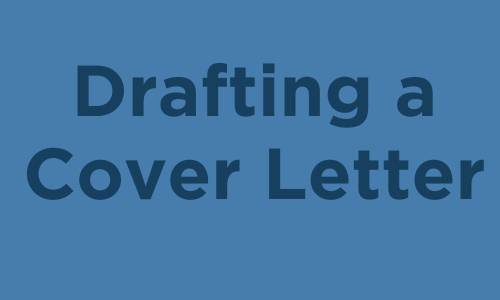
It is always a good idea to include a cover letter — even when it is not required — when you are applying for a position and when you will not be having a face-to-face conversation with the person in charge of hiring.
Many job or internship applications only request a resume; however, a well-written cover letter serves to introduce your resume and gives you the opportunity to direct your reader’s attention to specific areas of your background. In addition, you can clearly outline for the employer what specifically about the job or internship is interesting to you and what appeals to you about their particular company or organization — something you cannot do with a resume.
Getting Started on Your Cover Letter
Questions to ask yourself before writing your cover letter:
Things to Keep in Mind as You Construct Your Cover Letter
- Target your letter to match each particular organization or position being sought.
- Address your cover letter to a specific individual whenever possible. Use “Hiring Manager,” “Internship Coordinator,” or “Human Resources” instead of “To Whom It May Concern.”
- If someone has referred you to this position or company (e.g., an alumni contact, family friend, or parent), mention this at the beginning of the letter.
- Match your skills to the skills the employer is seeking and give concrete examples.
- Focus on how you can contribute, not just what you have done.
- Use transitions where appropriate and reduce the number of times the word “I” is used.
Communicating Professionally
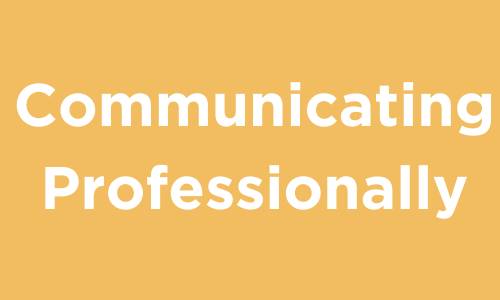
When meeting someone in person isn’t feasible, there are other strategies for reaching out to professional networking contacts.
Depending on the situation, these approaches can be informal or formal. The following methods create a first impression of your communication skills, interests and motivation, and knowledge about the organization or field.
Share your business card
Contrary to popular belief, business cards are not just for the employed. Many savvy young professionals (students and new grads) develop business cards as a communication tool used at conferences, networking events, and even in unexpected day-to-day interactions.
Why share your business card?
- Sharing contacts digitally can be impersonal; physically handing a card to someone is a personal interaction with potential to create a lasting impression.
- Exchanging your business card is a strategy for concluding an initial networking conversation and a promise to continue developing the relationship with your new connection.
- It shows you are prepared; you understand the culture of networking.
- Cards serve as evidence of your style and brand, especially if you have taken a creative approach to the design or in your material.
Remember, design and quality matter, but content is the focus. Include accurate contact information and a tagline description of what you want people to remember, such as: Research and Development, GVSU Biology Student, or Student Athlete.
Connect on LinkedIn
If you share a connection with someone on LinkedIn, you can connect with them without upgrading your account. Once you click the “Connect” button, you can send a short message to accompany your connection request. In your message, be clear and concise regarding your reason for reaching out.
Why connect on LinkedIn?
- You met someone professionally and would like to solidify them as a part of your network.
- You are interested in learning more about an organization and want to connect with someone who works there.
- You find a GVSU alumnus profile that contains a job history you’re excited about, and you want to learn more.
- You want to connect with someone in human resources at an organization where you’d like to work.
Express interest via email
It is appropriate to email a company that may not have an advertised job opening. A job inquiry letter, also known as an email inquiry, or email/letter of interest expresses your interest in the organization and will hopefully help you connect with people who work there (perhaps human resources professionals or hiring managers).
These emails should contain information about why the organization interests you and how your skills and experience would be an asset to them. The email should be brief and end with a call to action (what you hope will happen as a result of reading our email), e.g. an email back, a contact name, or an answer to a specific question.
Write a thank you note
A thank you note communicates not only your appreciation for the recent interaction you had with another person, but also that you are willing to act on your appreciation after reflection—a powerful message to send whether it is an email or handwritten. Follow these small steps to make a big impression:
- Who are you writing to? Ex. Dear Mr. Farley:
- What are you thanking them for? Ex. What a relief to meet you at the Career Fair—thank you for noticing that I was nervous while waiting in line.
- Add a specific detail about why this was impactful. Ex. Looking around, I thought it was so obvious that I was a first-year student. It was reassuring when you said that employers think that is great initiative but I truly relaxed when you introduced me to the recruiter and helped me start a professional conversation. I left Career Fair feeling excited—I couldn’t wait to tell my roommate who said I shouldn’t go.
- Write a looking forward statement. Ex. Next time I attend a fair, I will still be nervous but also excited. I look forward to seeing you there.
- Reiterate your thanks. Ex. Thank you Mr. Farley, I couldn’t have done that without you.
- Proof-read, sign and send.


[1694716375].jpg)
